brake YAMAHA WR 250F 2015 Owners Manual
[x] Cancel search | Manufacturer: YAMAHA, Model Year: 2015, Model line: WR 250F, Model: YAMAHA WR 250F 2015Pages: 430, PDF Size: 14.14 MB
Page 9 of 430

EAS2GB2007
SYMBOLS
The following symbols are used in this manual for easier understanding.
TIP
The following symbols are not relevant to every vehicle.
SYMBOL DEFINITION SYMBOL DEFINITION
Serviceable with engine mounted Gear oil
Filling fluid Molybdenum disulfide oil
Lubricant Brake fluid
Special tool Wheel bearing grease
Tightening torque Lithium-soap-based grease
Wear limit, clearance Molybdenum disulfide grease
Engine speed Silicone grease
Electrical data Locking agent (LOCTITE®)
Engine oil Replace the part with a new one.
G
M
BF
B
T R..
LS
M
S
LT
E
New
Page 14 of 430

CONTROL FUNCTIONS................................................................................ 1-21
INDICATOR LIGHTS AND WARNING LIGHTS ....................................... 1-21
ENGINE STOP SWITCH .......................................................................... 1-21
START SWITCH....................................................................................... 1-21
CLUTCH LEVER...................................................................................... 1-21
SHIFT PEDAL .......................................................................................... 1-22
KICKSTARTER LEVER............................................................................ 1-22
THROTTLE GRIP ..................................................................................... 1-22
FRONT BRAKE LEVER ........................................................................... 1-22
REAR BRAKE PEDAL.............................................................................. 1-22
SIDESTAND ............................................................................................. 1-23
STARTER KNOB/IDLE ADJUSTING SCREW ......................................... 1-23
FUEL TANK CAP ..................................................................................... 1-23
MULTI-FUNCTION DISPLAY......................................................................... 1-24
DESCRIPTION ......................................................................................... 1-24
BASIC MODE ........................................................................................... 1-24
CHANGEOVER TO BASIC MODE/RACE MODE.................................... 1-25
RACE MODE ............................................................................................ 1-26
FUNCTION DIAGRAM ............................................................................. 1-30
STARTING AND BREAK-IN.......................................................................... 1-32
FUEL ........................................................................................................ 1-32
HANDLING NOTE .................................................................................... 1-32
AIR FILTER MAINTENANCE ................................................................... 1-32
STARTING A COLD ENGINE .................................................................. 1-32
STARTING A WARM ENGINE ................................................................. 1-33
BREAK-IN PROCEDURES ...................................................................... 1-34
MAINTENANCE AFTER BREAK-IN.............................................................. 1-35
MAJOR MAINTENANCE .......................................................................... 1-35
TORQUE-CHECK POINTS............................................................................ 1-36
MOTORCYCLE CARE AND STORAGE........................................................ 1-38
CARE........................................................................................................ 1-38
STORAGE ................................................................................................ 1-39
Page 18 of 430

DESCRIPTION
1-4
EAS2GB2009
DESCRIPTION
TIP
Designs and specifications of the vehicle are subject to change without notice. Therefore, please
note that the descriptions in this manual may be different from those for the vehicle you have pur-
chased.1. Clutch lever 12. Headlight
2. Multi-function display 13. Radiator
3. Front brake lever 14. Coolant drain bolt
4. Throttle grip 15. Rear brake pedal
5. Start switch 16. Air filter
6. Radiator cap 17. Drive chain
7. Fuel tank cap 18. Shift pedal
8. Engine stop switch 19. Oil level check window
9. Taillight 20. Starter knob/idle screw
10. Fuel tank 21. Front fork
11. Kickstarter lever
32 1
8
10
91112 1376
54
15 14 21 20 19 18 1716
Page 36 of 430
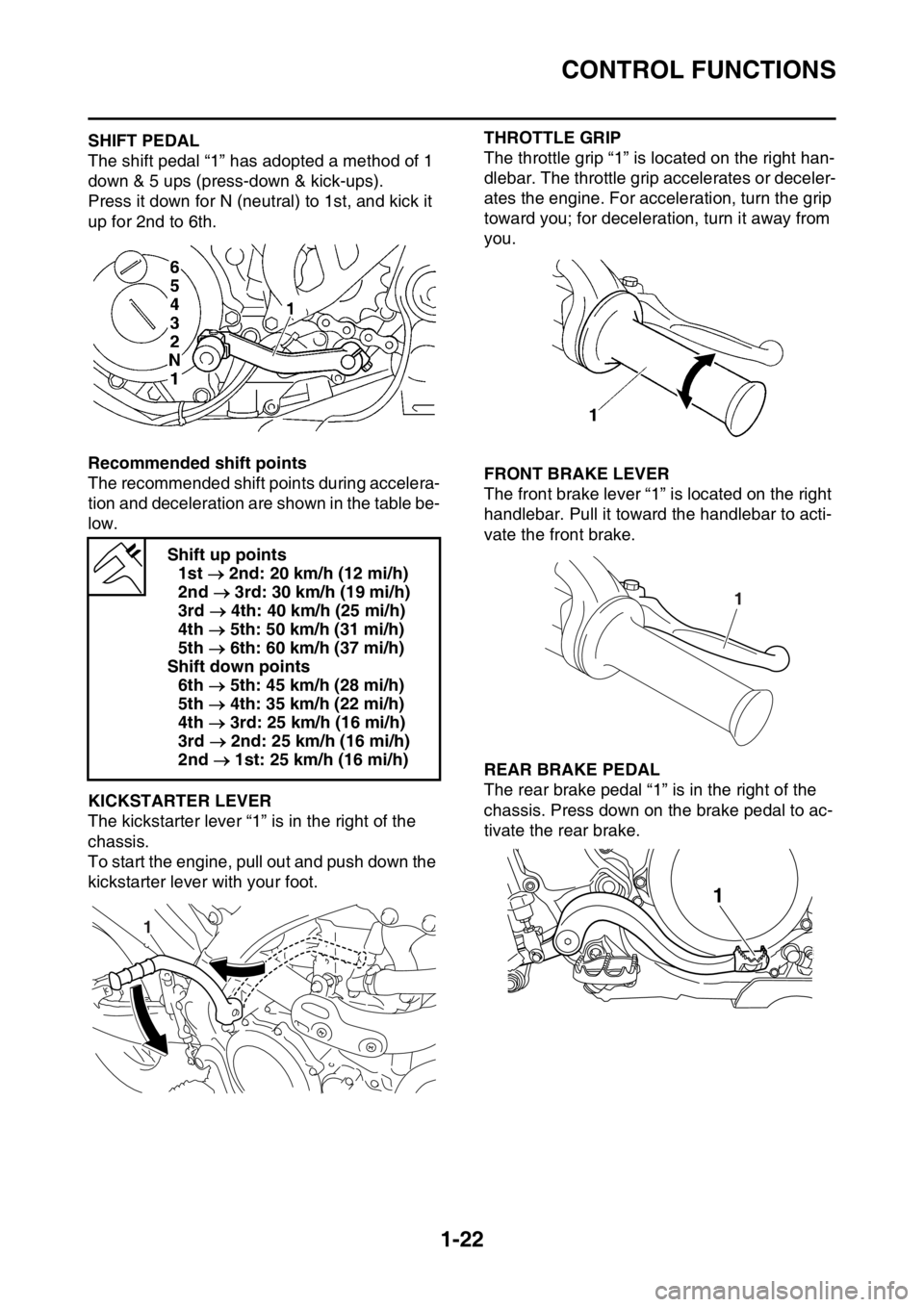
CONTROL FUNCTIONS
1-22
EAS2GB2036SHIFT PEDAL
The shift pedal “1” has adopted a method of 1
down & 5 ups (press-down & kick-ups).
Press it down for N (neutral) to 1st, and kick it
up for 2nd to 6th.
Recommended shift points
The recommended shift points during accelera-
tion and deceleration are shown in the table be-
low.
EAS2GB2037KICKSTARTER LEVER
The kickstarter lever “1” is in the right of the
chassis.
To start the engine, pull out and push down the
kickstarter lever with your foot.
EAS2GB2038
THROTTLE GRIP
The throttle grip “1” is located on the right han-
dlebar. The throttle grip accelerates or deceler-
ates the engine. For acceleration, turn the grip
toward you; for deceleration, turn it away from
you.
EAS2GB2039FRONT BRAKE LEVER
The front brake lever “1” is located on the right
handlebar. Pull it toward the handlebar to acti-
vate the front brake.
EAS2GB2040REAR BRAKE PEDAL
The rear brake pedal “1” is in the right of the
chassis. Press down on the brake pedal to ac-
tivate the rear brake. Shift up points
1st 2nd: 20 km/h (12 mi/h)
2nd 3rd: 30 km/h (19 mi/h)
3rd 4th: 40 km/h (25 mi/h)
4th 5th: 50 km/h (31 mi/h)
5th 6th: 60 km/h (37 mi/h)
Shift down points
6th 5th: 45 km/h (28 mi/h)
5th 4th: 35 km/h (22 mi/h)
4th 3rd: 25 km/h (16 mi/h)
3rd 2nd: 25 km/h (16 mi/h)
2nd 1st: 25 km/h (16 mi/h)
1
1
1
Page 48 of 430

STARTING AND BREAK-IN
1-34
EAS2GB2056BREAK-IN PROCEDURES
A break-in is important so that rotating portion,
sliding surfaces, and mounted areas may fit
one another, and that the rider may become ac-
customed to the machine.
ECA
NOTICE
Before running, do maintenance on the air
filter element.
Refer to “CLEANING THE AIR FILTER ELE-
MENT” on page 3-14.
1. After warming up the engine, drive it for
about 20 minutes at a throttle opening of 1/2
or less.
2. Make a pit stop, and check mounted areas
for looseness, oil leaks, or other problems.
3. Then, drive it for about 40 minutes at a throt-
tle opening of 3/4 or less.
4. Make a pit stop again, and thoroughly check
mounted areas for looseness, oil leaks, or
other problems. Thorough checks and ad-
justments are required in particular for
stretch of cables, free play of the brake,
stretch of the drive chain, looseness of the
spoke, and so on.
ECA
NOTICE
After a break-in or after each race, always
check the points shown in “TORQUE-
CHECK POINTS” for tightening torques and
retighten them. (Refer to “TORQUE-CHECK
POINTS” on page 1-36.)
Also when the following parts are replaced,
a break-in is required.
• Cylinder and Crankshaft: A break-in is re-
quired for about an hour.
• Piston, Piston ring, Valve, Camshaft, and
Gear: A break-in is required for about 30
minutes at a throttle opening of 1/2 or less.
Observe the condition of the engine careful-
ly during a break-in.
For checkpoints for a break-in, see “MAIN-
TENANCE AFTER BREAK-IN”. If any prob-
lem is found, immediately stop the engine
and make a checkup.
Page 49 of 430
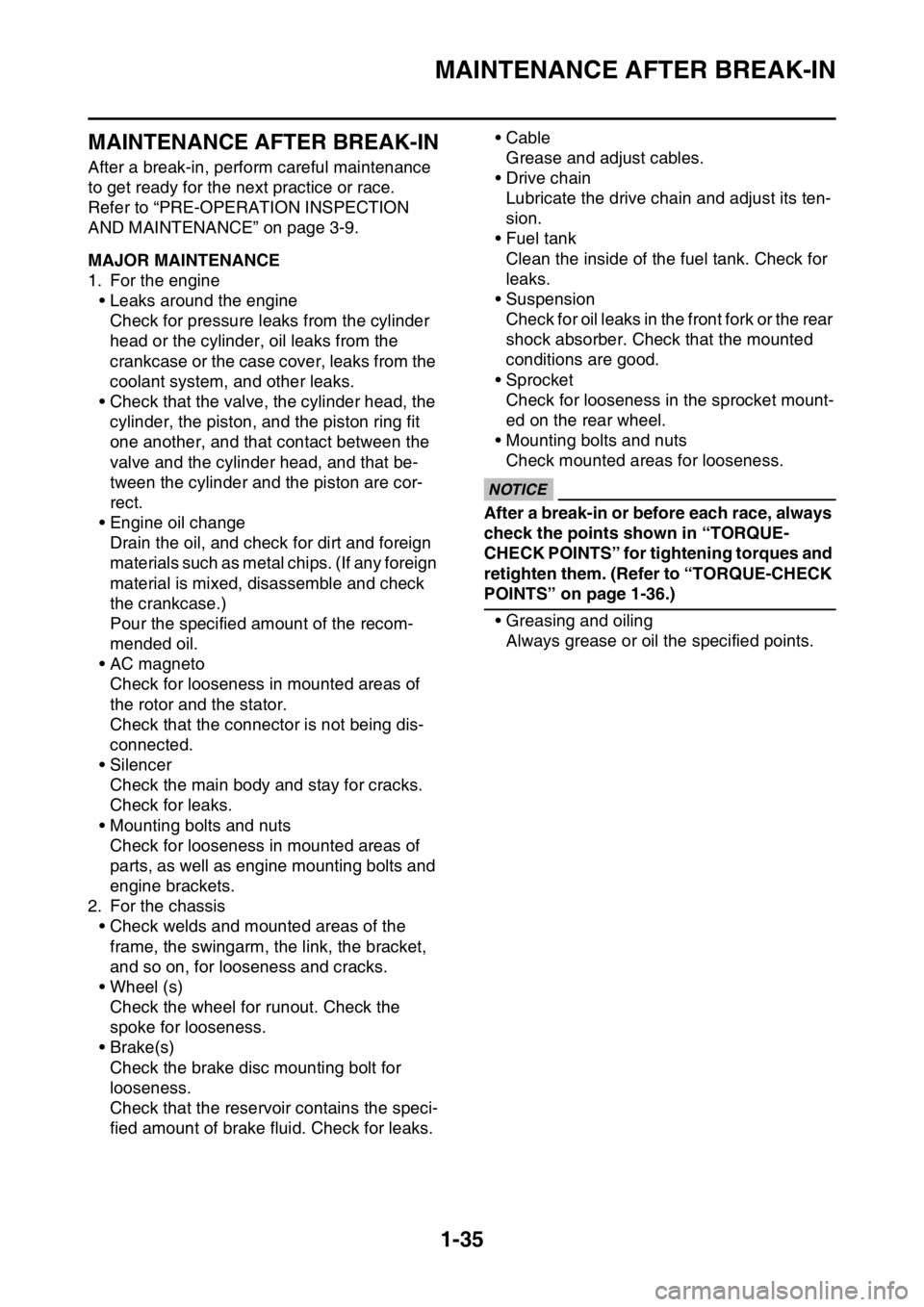
MAINTENANCE AFTER BREAK-IN
1-35
EAS2GB2057
MAINTENANCE AFTER BREAK-IN
After a break-in, perform careful maintenance
to get ready for the next practice or race.
Refer to “PRE-OPERATION INSPECTION
AND MAINTENANCE” on page 3-9.
EAS2GB2058MAJOR MAINTENANCE
1. For the engine
• Leaks around the engine
Check for pressure leaks from the cylinder
head or the cylinder, oil leaks from the
crankcase or the case cover, leaks from the
coolant system, and other leaks.
• Check that the valve, the cylinder head, the
cylinder, the piston, and the piston ring fit
one another, and that contact between the
valve and the cylinder head, and that be-
tween the cylinder and the piston are cor-
rect.
• Engine oil change
Drain the oil, and check for dirt and foreign
materials such as metal chips. (If any foreign
material is mixed, disassemble and check
the crankcase.)
Pour the specified amount of the recom-
mended oil.
• AC magneto
Check for looseness in mounted areas of
the rotor and the stator.
Check that the connector is not being dis-
connected.
• Silencer
Check the main body and stay for cracks.
Check for leaks.
• Mounting bolts and nuts
Check for looseness in mounted areas of
parts, as well as engine mounting bolts and
engine brackets.
2. For the chassis
• Check welds and mounted areas of the
frame, the swingarm, the link, the bracket,
and so on, for looseness and cracks.
• Wheel (s)
Check the wheel for runout. Check the
spoke for looseness.
• Brake(s)
Check the brake disc mounting bolt for
looseness.
Check that the reservoir contains the speci-
fied amount of brake fluid. Check for leaks.• Cable
Grease and adjust cables.
•Drive chain
Lubricate the drive chain and adjust its ten-
sion.
• Fuel tank
Clean the inside of the fuel tank. Check for
leaks.
• Suspension
Check for oil leaks in the front fork or the rear
shock absorber. Check that the mounted
conditions are good.
• Sprocket
Check for looseness in the sprocket mount-
ed on the rear wheel.
• Mounting bolts and nuts
Check mounted areas for looseness.
ECA
NOTICE
After a break-in or before each race, always
check the points shown in “TORQUE-
CHECK POINTS” for tightening torques and
retighten them. (Refer to “TORQUE-CHECK
POINTS” on page 1-36.)
• Greasing and oiling
Always grease or oil the specified points.
Page 50 of 430

TORQUE-CHECK POINTS
1-36
EAS2GB2059
TORQUE-CHECK POINTS
Frame construction Frame to rear frame
Frame to engine protector
Combined seat and fuel tank Fuel tank to frame
Engine mounting Frame to engine
Engine bracket to engine
Engine bracket to frame
Seat Seat to frame
Steering Steering stem to handlebar Steering stem to frame
Steering stem to upper bracket
Upper bracket to handlebar
Suspension Front Steering stem to front fork Front fork to upper bracket
Front fork to lower bracket
Rear Link Assembly of links
Link to frame
Link to rear shock absorber
Link to swingarm
Mounting of rear shock absorber Rear shock absorber and frame
Mounting of swingarm Tightening of pivot shaft
Wheel (s) Mounting of wheel Front Tightening of wheel axle
Tightening of axle holder
Tightening of spoke nipple
Rear Tightening of wheel axle
Wheel to rear wheel sprocket
Tightening of spoke nipple
Brake(s) Front Brake caliper to front fork
Brake disc to wheel
Tightening of union bolt
Brake master cylinder to handle-
bar
Tightening of bleed screw
Tightening of brake hose holder
Rear Brake pedal to frame
Brake disc to wheel
Tightening of union bolt
Brake master cylinder to frame
Tightening of bleed screw
Tightening of brake hose holder
Shift pedal Shift pedal to shift shaft
Page 51 of 430
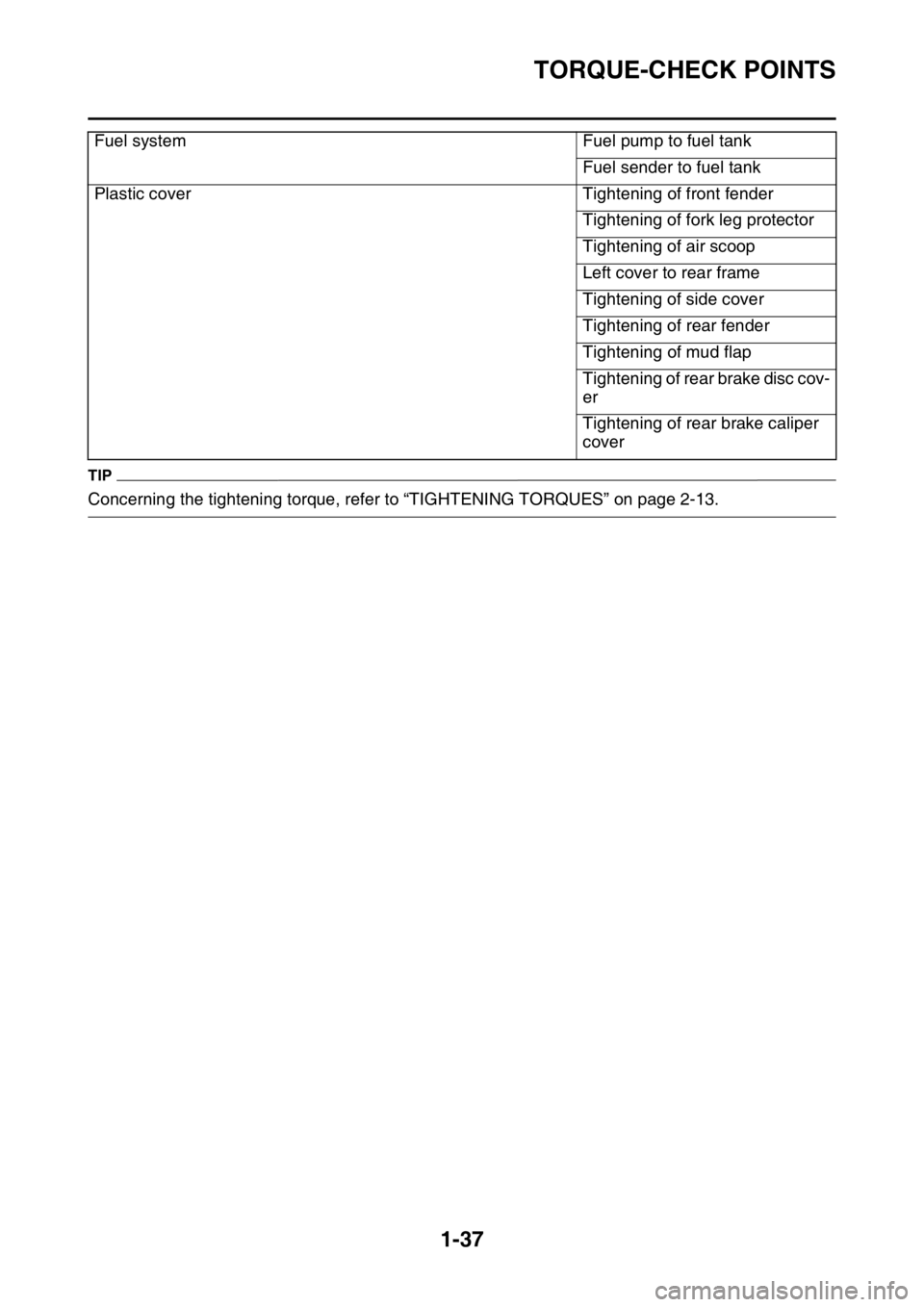
TORQUE-CHECK POINTS
1-37
TIP
Concerning the tightening torque, refer to “TIGHTENING TORQUES” on page 2-13.Fuel system Fuel pump to fuel tank
Fuel sender to fuel tank
Plastic cover Tightening of front fender
Tightening of fork leg protector
Tightening of air scoop
Left cover to rear frame
Tightening of side cover
Tightening of rear fender
Tightening of mud flap
Tightening of rear brake disc cov-
er
Tightening of rear brake caliper
cover
Page 52 of 430
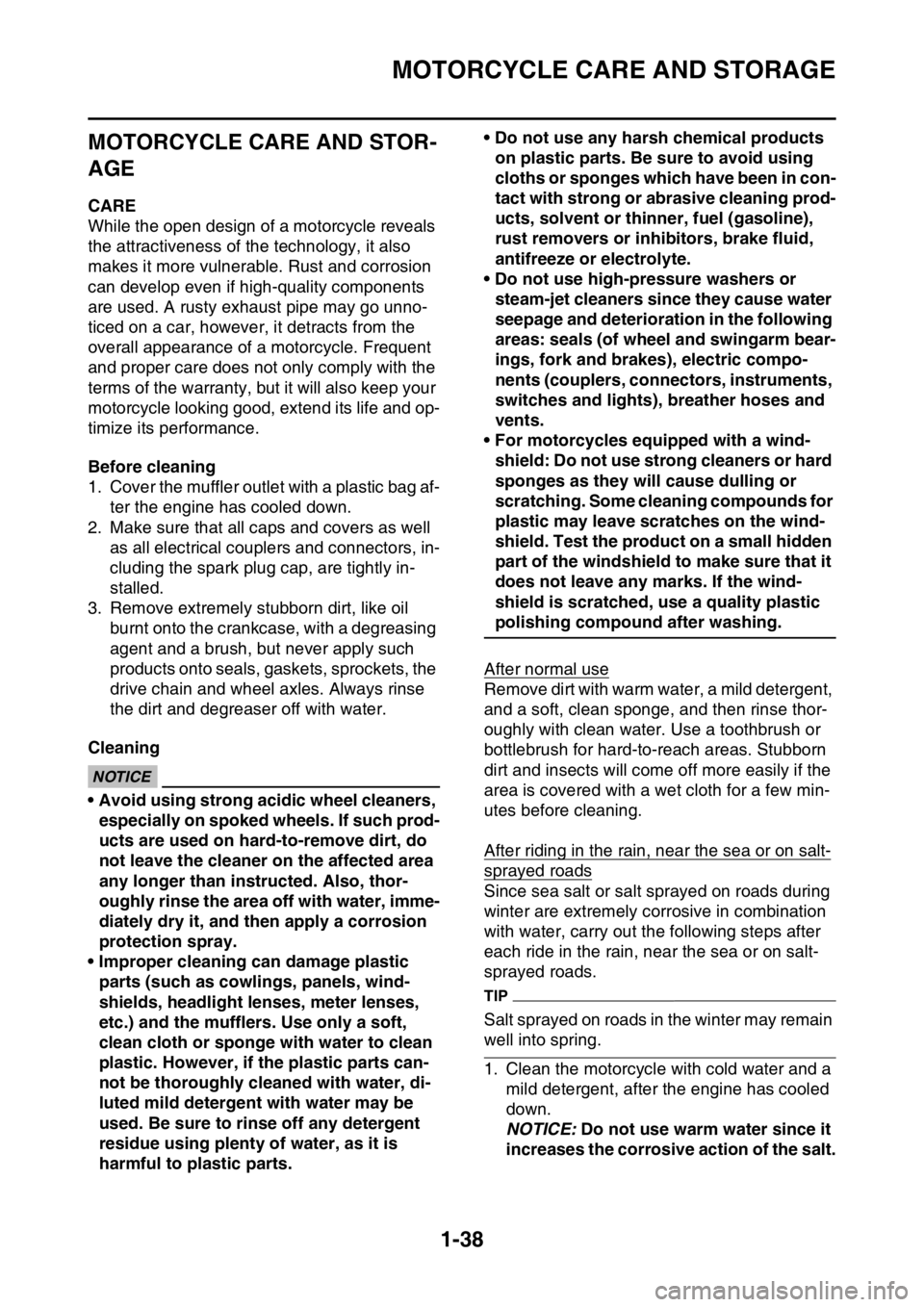
MOTORCYCLE CARE AND STORAGE
1-38
EAS2GB2060
MOTORCYCLE CARE AND STOR-
AGE
EAS2GB2061CARE
While the open design of a motorcycle reveals
the attractiveness of the technology, it also
makes it more vulnerable. Rust and corrosion
can develop even if high-quality components
are used. A rusty exhaust pipe may go unno-
ticed on a car, however, it detracts from the
overall appearance of a motorcycle. Frequent
and proper care does not only comply with the
terms of the warranty, but it will also keep your
motorcycle looking good, extend its life and op-
timize its performance.
Before cleaning
1. Cover the muffler outlet with a plastic bag af-
ter the engine has cooled down.
2. Make sure that all caps and covers as well
as all electrical couplers and connectors, in-
cluding the spark plug cap, are tightly in-
stalled.
3. Remove extremely stubborn dirt, like oil
burnt onto the crankcase, with a degreasing
agent and a brush, but never apply such
products onto seals, gaskets, sprockets, the
drive chain and wheel axles. Always rinse
the dirt and degreaser off with water.
Cleaning
ECA
NOTICE
• Avoid using strong acidic wheel cleaners,
especially on spoked wheels. If such prod-
ucts are used on hard-to-remove dirt, do
not leave the cleaner on the affected area
any longer than instructed. Also, thor-
oughly rinse the area off with water, imme-
diately dry it, and then apply a corrosion
protection spray.
• Improper cleaning can damage plastic
parts (such as cowlings, panels, wind-
shields, headlight lenses, meter lenses,
etc.) and the mufflers. Use only a soft,
clean cloth or sponge with water to clean
plastic. However, if the plastic parts can-
not be thoroughly cleaned with water, di-
luted mild detergent with water may be
used. Be sure to rinse off any detergent
residue using plenty of water, as it is
harmful to plastic parts.• Do not use any harsh chemical products
on plastic parts. Be sure to avoid using
cloths or sponges which have been in con-
tact with strong or abrasive cleaning prod-
ucts, solvent or thinner, fuel (gasoline),
rust removers or inhibitors, brake fluid,
antifreeze or electrolyte.
• Do not use high-pressure washers or
steam-jet cleaners since they cause water
seepage and deterioration in the following
areas: seals (of wheel and swingarm bear-
ings, fork and brakes), electric compo-
nents (couplers, connectors, instruments,
switches and lights), breather hoses and
vents.
• For motorcycles equipped with a wind-
shield: Do not use strong cleaners or hard
sponges as they will cause dulling or
scratching. Some cleaning compounds for
plastic may leave scratches on the wind-
shield. Test the product on a small hidden
part of the windshield to make sure that it
does not leave any marks. If the wind-
shield is scratched, use a quality plastic
polishing compound after washing.
After normal use
Remove dirt with warm water, a mild detergent,
and a soft, clean sponge, and then rinse thor-
oughly with clean water. Use a toothbrush or
bottlebrush for hard-to-reach areas. Stubborn
dirt and insects will come off more easily if the
area is covered with a wet cloth for a few min-
utes before cleaning.
After riding in the rain, near the sea or on salt-
sprayed roads
Since sea salt or salt sprayed on roads during
winter are extremely corrosive in combination
with water, carry out the following steps after
each ride in the rain, near the sea or on salt-
sprayed roads.
TIP
Salt sprayed on roads in the winter may remain
well into spring.
1. Clean the motorcycle with cold water and a
mild detergent, after the engine has cooled
down.
NOTICE: Do not use warm water since it
increases the corrosive action of the salt.
Page 53 of 430
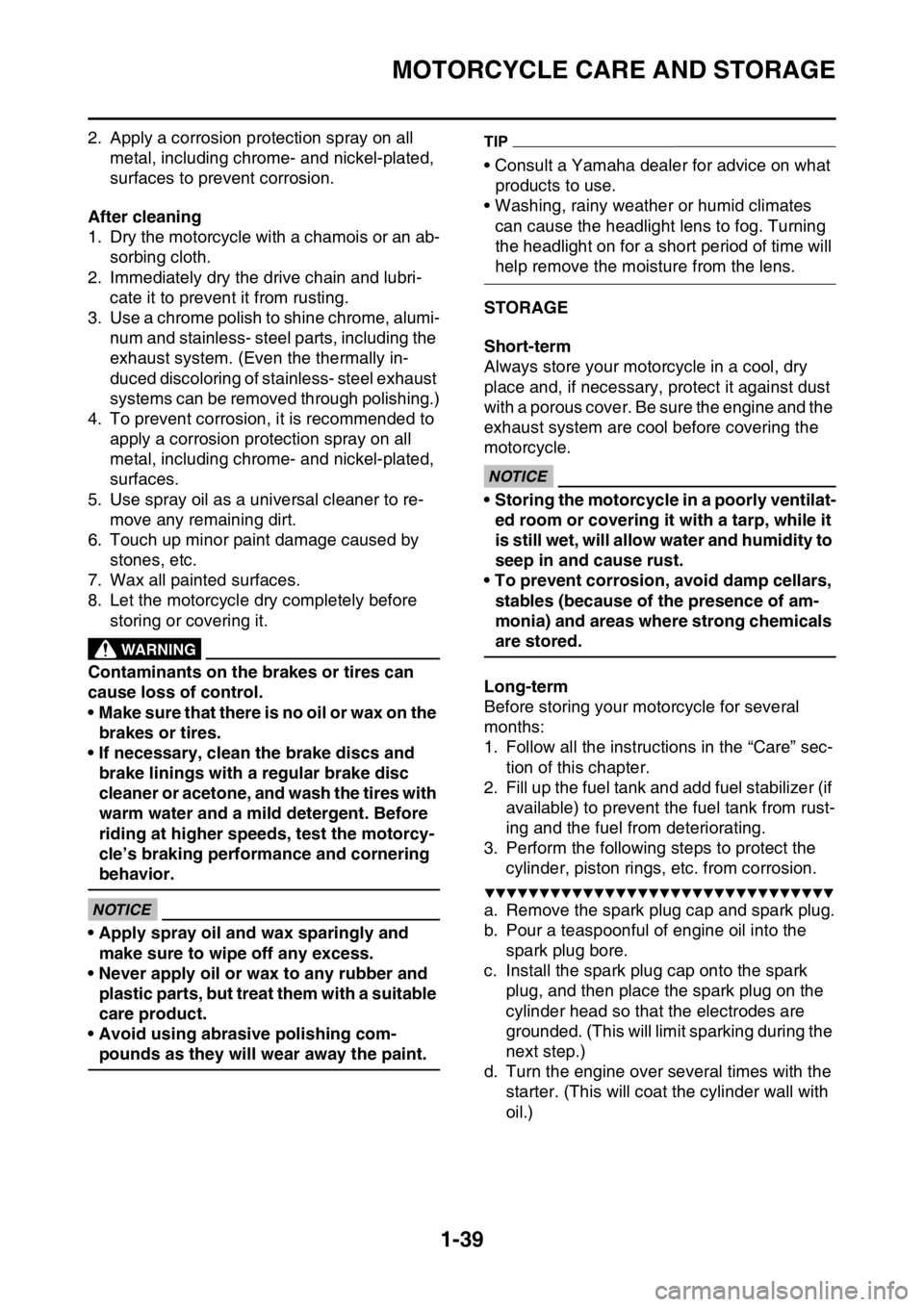
MOTORCYCLE CARE AND STORAGE
1-39
2. Apply a corrosion protection spray on all
metal, including chrome- and nickel-plated,
surfaces to prevent corrosion.
After cleaning
1. Dry the motorcycle with a chamois or an ab-
sorbing cloth.
2. Immediately dry the drive chain and lubri-
cate it to prevent it from rusting.
3. Use a chrome polish to shine chrome, alumi-
num and stainless- steel parts, including the
exhaust system. (Even the thermally in-
duced discoloring of stainless- steel exhaust
systems can be removed through polishing.)
4. To prevent corrosion, it is recommended to
apply a corrosion protection spray on all
metal, including chrome- and nickel-plated,
surfaces.
5. Use spray oil as a universal cleaner to re-
move any remaining dirt.
6. Touch up minor paint damage caused by
stones, etc.
7. Wax all painted surfaces.
8. Let the motorcycle dry completely before
storing or covering it.
EWA
WARNING
Contaminants on the brakes or tires can
cause loss of control.
• Make sure that there is no oil or wax on the
brakes or tires.
• If necessary, clean the brake discs and
brake linings with a regular brake disc
cleaner or acetone, and wash the tires with
warm water and a mild detergent. Before
riding at higher speeds, test the motorcy-
cle’s braking performance and cornering
behavior.
ECA
NOTICE
• Apply spray oil and wax sparingly and
make sure to wipe off any excess.
• Never apply oil or wax to any rubber and
plastic parts, but treat them with a suitable
care product.
• Avoid using abrasive polishing com-
pounds as they will wear away the paint.
TIP
• Consult a Yamaha dealer for advice on what
products to use.
• Washing, rainy weather or humid climates
can cause the headlight lens to fog. Turning
the headlight on for a short period of time will
help remove the moisture from the lens.
EAS2GB2062STORAGE
Short-term
Always store your motorcycle in a cool, dry
place and, if necessary, protect it against dust
with a porous cover. Be sure the engine and the
exhaust system are cool before covering the
motorcycle.
ECA
NOTICE
• Storing the motorcycle in a poorly ventilat-
ed room or covering it with a tarp, while it
is still wet, will allow water and humidity to
seep in and cause rust.
• To prevent corrosion, avoid damp cellars,
stables (because of the presence of am-
monia) and areas where strong chemicals
are stored.
Long-term
Before storing your motorcycle for several
months:
1. Follow all the instructions in the “Care” sec-
tion of this chapter.
2. Fill up the fuel tank and add fuel stabilizer (if
available) to prevent the fuel tank from rust-
ing and the fuel from deteriorating.
3. Perform the following steps to protect the
cylinder, piston rings, etc. from corrosion.
▼▼▼▼▼▼▼▼▼▼▼▼▼▼▼▼▼▼▼▼▼▼▼▼▼▼▼▼▼▼▼▼
a. Remove the spark plug cap and spark plug.
b. Pour a teaspoonful of engine oil into the
spark plug bore.
c. Install the spark plug cap onto the spark
plug, and then place the spark plug on the
cylinder head so that the electrodes are
grounded. (This will limit sparking during the
next step.)
d. Turn the engine over several times with the
starter. (This will coat the cylinder wall with
oil.)